<Back to Index>
- Marshal of Italy, Prime Minister of Italy Pietro Badoglio, 1871
- Marshal of Italy Ugo Cavallero, 1880
PAGE SPONSOR
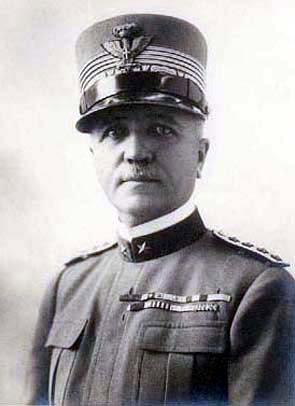
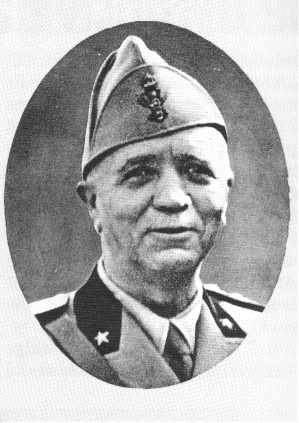
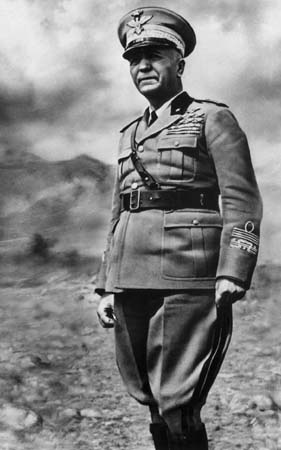
Pietro Badoglio, 1st Duke of Addis Abeba, 1st Marquess of Sabotino (28 September 1871 – 1 November 1956) was an Italian soldier and politician. He was a member of the National Fascist Party and commanded fascist troops under Italian dictator Benito Mussolini in the Second Italo - Abyssinian War and is an alleged war criminal for the use of poison gas and systematically bombarding and strafing Red Cross hospitals and ambulances during the Ethiopia campaign. Due to post - war expediencies, however, he was never brought to justice.
On 24 July 1943, as Italy had suffered several setbacks in World War II, Mussolini summoned the Fascist Grand Council, which voted no confidence in Mussolini. The following day Il Duce was removed from government by King Victor Emmanuel III and arrested. Badoglio was named Prime Minister of Italy and while mass confusion in Italy reigned, he eventually signed an armistice with the Allies. When this was made public, it threw Italy into chaos. A civil war took place, and the fascists fought the partisans. The king and Badoglio fled Rome leaving the Italian Army with no orders to follow.
Eventually from Brindisi on 13 October, Badoglio and the Kingdom of Italy declared war against Nazi Germany.
Badoglio did not stay as Prime Minister for long however, as world
opinion at that stage desired a person with a non - Fascist past to head
the government. In June 1944, Badoglio was replaced by Ivanoe Bonomi of the Labor Democratic Party.
He was born in Grazzano Monferrato (later Grazzano Badoglio) in the province of Asti (Piedmont).
After studying at the military academy in Turin, he served with the Italian Army from 1892, at first as a Lieutenant (Tenente) in artillery, taking part in the campaigns in Eritrea (1896) and Libya (1912), where he distinguished himself at the Battle of Zanzur.
At the beginning of Italian participation in World War I, he was a Lieutenant Colonel (Tenente Colonnello); he rose to the rank of General following his handling of the capture of Monte Sabotino in May 1916 and by the late months of 1917 (mostly thanks to his Masonic contacts, including his superior, General Capello) was named as Vice Chief - of - Staff (Sottocapo di Stato Maggiore) despite being one of the main leaders responsible for the disaster during the Battle of Caporetto on 24 October 1917.
In
the years after World War I, in which he held several high ranks in the
Italian Army, Badoglio exerted a constant effort in modifying official
documents in order to hide his role in the defeat.
Post - war, Badoglio was named as a Senator, but also remained in the army with special assignments to Romania and the U.S. in 1920 and 1921. At first, he opposed Benito Mussolini and after 1922 was sidelined as ambassador to Brazil. A change of political heart soon returned him to Italy and a senior role in the army as Chief of Staff from 4 May 1924. On June 25, 1926, Badoglio was promoted to the rank of Marshal of Italy (Maresciallo d'Italia).
Badoglio was the first unique governor of Tripolitania and Cyrenaica (Italian Libya) from 1929 to 1933. During his governorship, he played a vital part (with Rodolfo Graziani, deputy governor of Cyrenaica) in defeating the Libyan rebels. On 24 January 1932, Badoglio proclaimed the end of Libyan resistance for the first time since the Italian invasion in 1911.
Badoglio was not in East Africa when Emilio de Bono began the invasion of Abyssinia on 3 October 1935. De Bono was the Commander - in - Chief of all Italian military forces invading Ethiopia and he was in direct command of the invasion army on the northern front. Ultimately, the progress of De Bono's invasion was judged to be too slow by Mussolini. As a result, Badoglio, who in the meantime had launched an epistolary campaign against De Bono, replaced the latter in December. After the December 26 torture and murder of downed Italian pilot Tito Minniti, Badoglio asked for and was given permission to use chemical warfare.
Badoglio was immediately faced with the Ethiopian "Christmas Offensive" and he sought and received approval for the use of mustard gas. He employed it to effectively destroy the Ethiopian armies confronting him on the northern front. Badoglio commanded the Italian invasion army at the First Battle of Tembien, the Battle of Amba Aradam, the Second Battle of Tembien, and the Battle of Shire. On 31 March, Badoglio defeated Emperor Haile Selassie commanding the last Ethiopian army on the northern front at the Battle of Maychew. On 26 April, with no Ethiopian resistance left between his forces and Addis Ababa, Badoglio launched his "March of the Iron Will" to take the Ethiopian capital city and end the war. By 2 May, Haile Selassie had fled the country.
On 5 May 1936, Marshal Badoglio led the victorious Italian troops into Addis Ababa. Mussolini declared King Victor Emmanuel to be the Emperor of Ethiopia, and Ethiopia became part of the Italian Empire. On this occasion, Badoglio was appointed the first Viceroy and Governor General of Ethiopia and ennobled with the victory title of Duke of Addis Abeba.
On 11 June 1936, Rodolfo Graziani replaced
Badoglio as Viceroy and Governor General of Ethiopia. Badoglio returned
to his duties as the Supreme Chief of the Italian General Staff.
According to Time magazine, Badoglio even joined the Fascist Party in early June.
Badoglio was not in favor of the Italian - German Pact of Steel and was pessimistic about the chances of Italian success in any European war but he did not oppose the decision of Mussolini and the King to declare war on France and Great Britain. Following the Italian army's poor performance in the invasion of Greece in December 1940, he resigned from the General Staff. Badoglio was replaced by Ugo Cavallero.
On 24 July 1943, following the Allied invasion of Sicily, there was a meeting of the Fascist Grand Council. On the following day, King Victor Emmanuel dismissed Mussolini as Prime Minister and appointed Badoglio to head the government in his place. Martial law was declared, Mussolini was arrested, and negotiations were covertly opened with the Allies. Publicly, the King and Badoglio claimed that Italy would remain with the Axis. Instead, they were plotting in the background.
On September 3, General Giuseppe Castellano signed the Italian armistice with the Allies in Cassibile on behalf of Badoglio. On September 8, the armistice document was published by the Allies in the Badoglio Proclamation. It was published before Badoglio could communicate news of the switch to the Italian armed forces. The units of the Royal Army, Royal Navy, and Royal Air Force were generally surprised by the switch and unprepared for German actions to disarm them. In the early hours of September 9, Badoglio, King Victor Emmanuel, some military ministries, and the Chief of the General Staff escaped to Pescara and Brindisi seeking Allied protection.
On 23 September, the longer version of the armistice was signed in Malta. The Badoglio government officially declared war on Germany on October 13. Badoglio continued to head the government for another nine months. Following the German rescue of Mussolini, the liberation of Rome, and increasingly strong opposition, he was replaced on 9 June 1944 by Ivanoe Bonomi and
other committed anti - Fascists. Badoglio was never tried for war crimes
by the Allies primarily because he helped them during the invasion of
Italy.
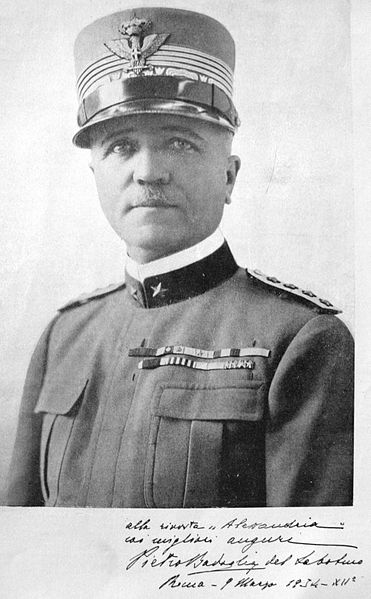
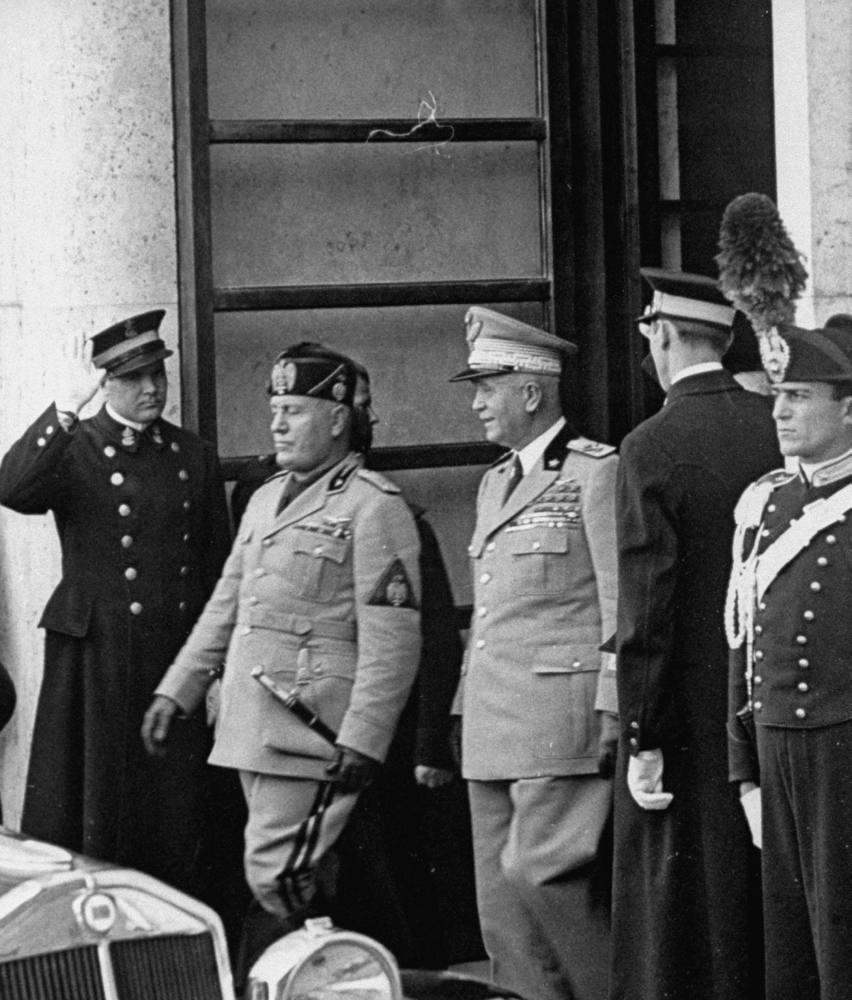
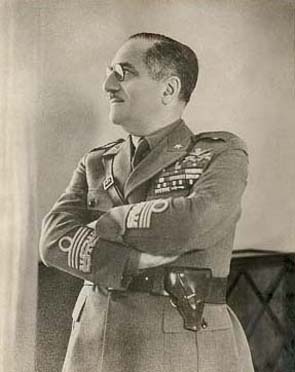
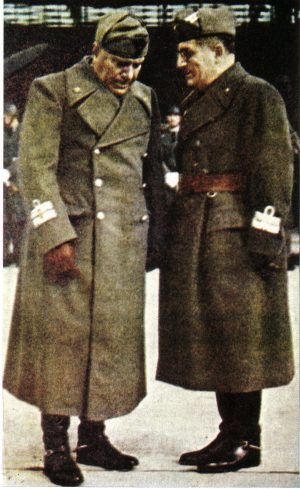
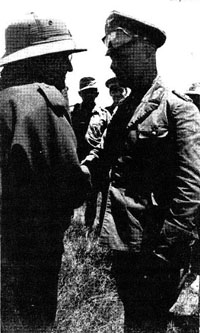
Ugo Cavallero (September 20, 1880 – September 13, 1943) was an Italian military commander before and during World War II. He was also a recipient of the Knight's Cross of the Iron Cross (German: Ritterkreuz des Eisernen Kreuzes). The Knight's Cross of the Iron Cross was awarded by the Third Reich to recognize extreme battlefield bravery or successful military leadership.
Born in Casale Monferrato, Piedmont, Cavallero had a privileged childhood as a member of the Italian nobility.
After attending military school, Cavallero was commissioned a Second Lieutenant in 1900.
Cavallero later attended college and graduated in 1911, earning a degree in mathematics.
Still in the army, Cavallero fought in Libya in 1913, during the Italo - Turkish War, and was awarded a Bronze Medal for Military Valor.
In 1915, Cavallero was transferred to the Italian Supreme Command. A brilliant organizer and tactician, Cavallero became a Brigadier General and Chief of the Operations Office of the Italian Supreme Command in 1918.
In this capacity, Cavallero was instrumental in forming plans that led to Italian victories at Piave and Vittorio Veneto during World War I. During his time as chief of the plan of Italian General Staff, he developed an antipathy with Pietro Badoglio the Sottocapo di Stato Maggiore (vice chief of the staff) of the army.
Cavallero retired from the army in 1919 but later rejoined in 1925, at which time he became Benito Mussolini’s Undersecretary of War. A committed fascist, Cavallero was made a senator in 1926 and in 1927 became a major general. After leaving the army for a second time, Cavallero became involved in business and diplomatic enterprises throughout the late 1920s and early 1930s.
Cavallero rejoined the army for the third and final time in 1937. Promoted to Lieutenant General, he became Commander of the combined Italian forces in Italian East Africa in 1938 and was made a full General in 1940.
After Italy entered World War II in June 1940, Cavallero was made the Commander - in - Chief of the Italian Army Group in Albania. In October, when Italy invaded Greece, he was the commander of the invading Italian forces. In December, he replaced Pietro Badoglio as the Chief of the Italian Supreme Command (Comando Supremo). Italian military activities in Greece remained part of Cavallero's responsibilities and oversight was added immediately of campaigns in the Western Desert and East Africa.
As Chief of the Italian Supreme Command, Cavallero worked closely with German Field Marshal Albert Kesselring and often asked for Kesselring’s advice on military matters. Cavallero opposed Field Marshal Erwin Rommel’s invasion of Egypt and campaigned for Rommel’s dismissal in 1942. But he was ignored by both Adolf Hitler and Benito Mussolini. Under Cavallero’s leadership, Italy’s military forces performed poorly during the war. Nonetheless, he was promoted to Marshal of Italy (Maresciallo d'Italia) in 1942 after the promotion of Rommel to Field Marshal. During his tenure as chief of general staff, his performance was very bad and he became famous for his optimistic view over the course of the war.
In July 1943, after several serious Italian setbacks (such as the Allies’ capture of Libya), Cavallero was dismissed as Chief of the Supreme Command (Commando Supremo) and replaced by Vittorio Ambrosio. In response to Cavallero's dismissal, members of the Fascist leadership like Galeazzo Ciano expressed their joy.
At the same time as Cavallero's dismissal, Mussolini’s government was toppled by the King and newly appointed Prime Minister Pietro Badoglio. Cavallero was arrested by Badoglio for his Fascist and pro - German views. In his own defense, Cavallero wrote a letter to Badoglio claiming he despised Mussolini and Fascism. But Badoglio did not believe him.
In September, when Badoglio’s government surrendered to the Allies, the Germans invaded Rome and rescued Cavallero. They planned to make him a commander of Italian military forces still loyal to Fascist ideals. However, the Germans found his anti - Fascist letter in Badoglio’s abandoned office and believed him to be a traitor.
Now hated by both the Germans and by the forces loyal to Badoglio, a desperate Cavallero committed suicide. On 13 September, he shot himself in the head. Whether he did so willingly is still a matter of some debate.